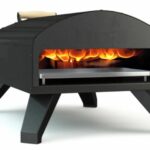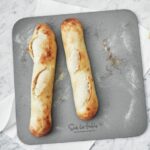The Best Fluffy Pancakes recipe you will fall in love with. Full of tips and tricks to help you make the best pancakes.
Ooni Pro Pizza Oven: great for pizza parties and pizza enthuasiasts
Ooni Pro Pizza Oven
This would be a great option if you want a multi-fueled pizza oven since you can use four different types of fuel – you can go with the one that best meets your method/style of cooking.
It’s an ideal option too for a family or casual entertaining as the interior is spacious enough to shell out large-sized pizzas in quick succession. You can utilize it at gatherings, parties and caterings where many people need to be fed.
The Pro is equally a large and heavy-duty model which makes it an ideal option if you don’t intend to transport or move your pizza oven often. The unit comes with a 1-year warranty but we did some further research and found the best deal is through Ooni’s website itself as they offer a 3-year warranty if you register the product and also a 60-day money-back guarantee.
Besides the size, the unit was able to deliver well-cooked pizzas in our tests. It was able to reach high temperatures and lock in the heat well for the most part. The other notable features that stood out were the thermometer built into the door, dual airflow control, and its sturdy overall construction.
Maintaining a steady temperature was a challenge though, especially when using wood as fuel. Other downsides we noted were long preheat time (especially with wood) and the pizzas sometimes sticking to the stone. The unit is also not really portable like the other Ooni pizza ovens.
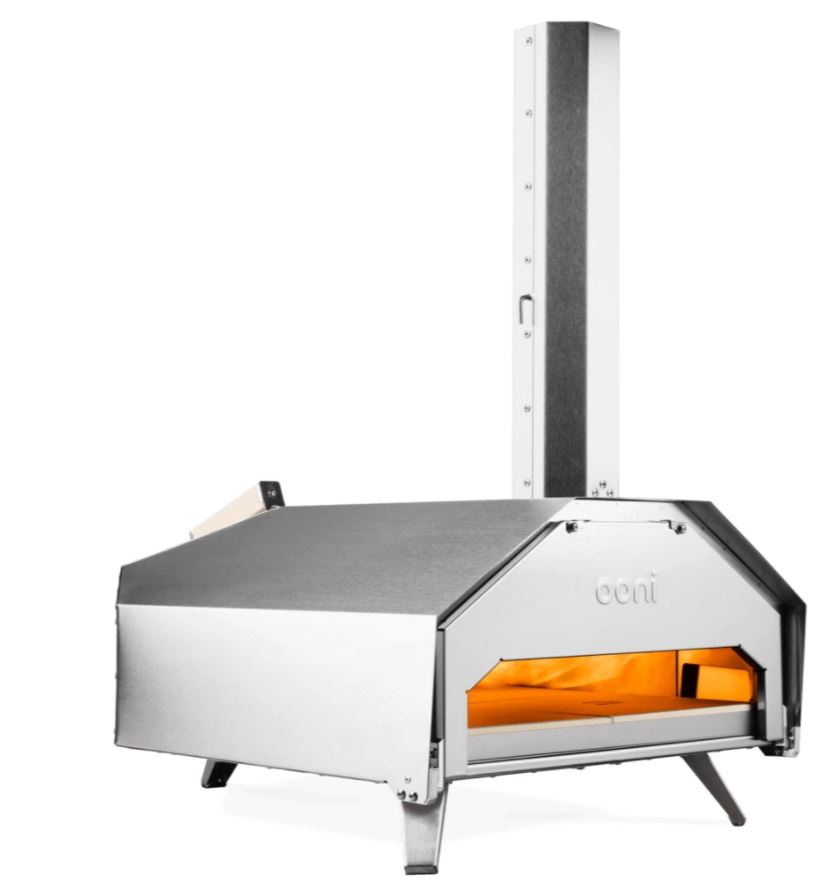
The Ooni Pro pizza oven is the big brother to the Ooni Koda and the Ooni Fyra models which we’ve tested not so long ago and shared our reviews herein. It’s our third Ooni pizza oven and we’ve had it on-hand for a couple of weeks.
We were extremely excited to test it out considering the great experience we had with the Koda and Fyra models. In this review, we will share our experience with it in detail including how well it works, how it compares to the other models and some of the drawbacks that it has.
The main selling point or what was appealing to us most is its versatility. It’s a multi-fuel pizza oven that can use four different fuels for cooking – it can run on charcoal, wood pellets, wood chunks and propane gas. It’s the most versatile pizza oven from Ooni. The only other one that comes close is the Ooni Karu (which can run on gas, charcoal or wood).
The other main selling point is the large cooking space. You can cook a large 16-inch pizza or 2 small 7-inch pizzas at a time in the Ooni Pro. It’s big enough to even roast large pieces of meat or bake bread. The Ooni Koda 16 model is the only other Ooni’s pizza oven that offers such a large cooking surface.
Design
The Ooni Pro is so basic in design compared to the Ooni Koda and Ooni Karu models. It’s very similar to the Ooni 3 model with the same style of design that features a tall decagonal chimney with an adjustable lever at the front, a burner at the back and short squat legs.
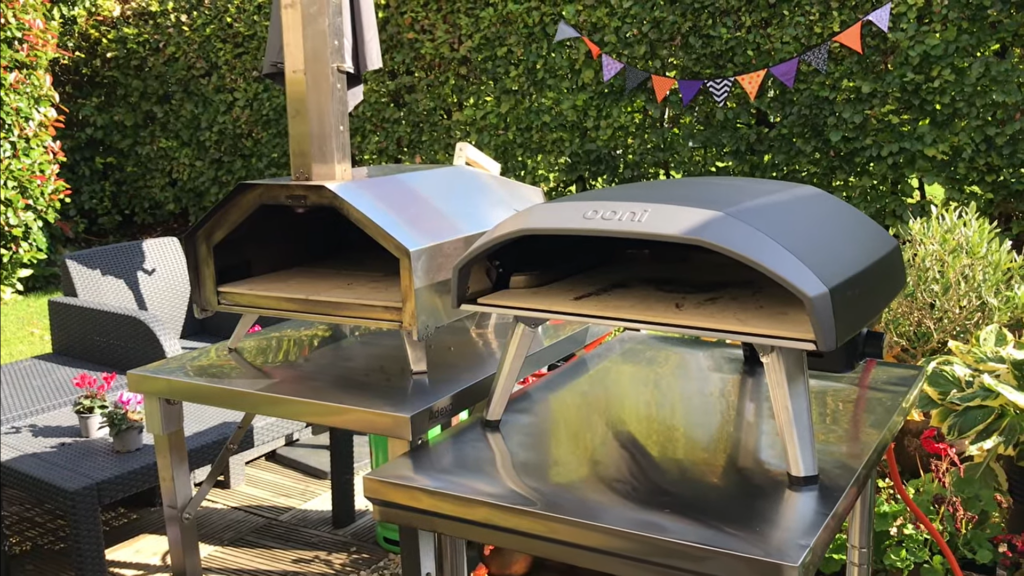
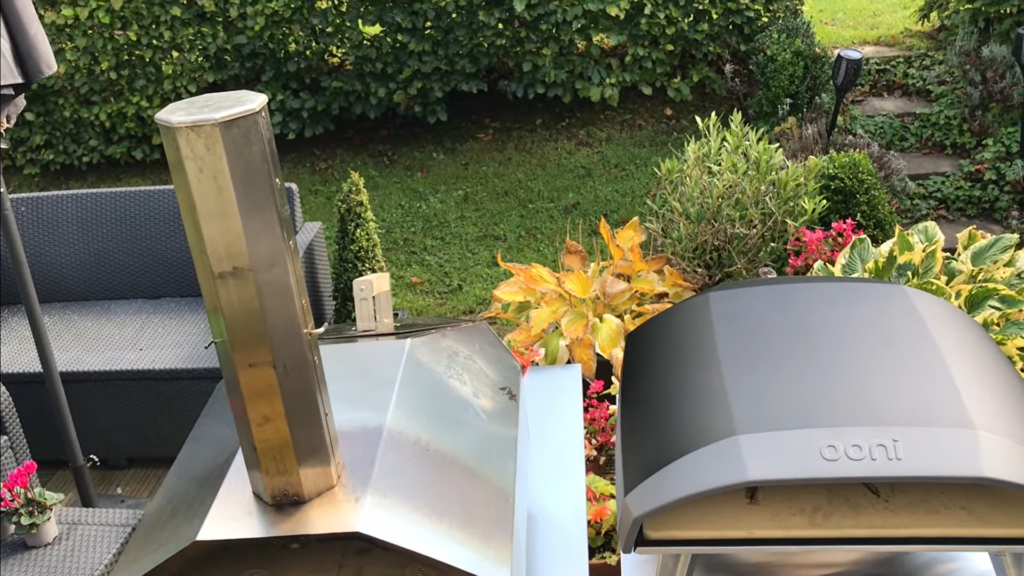
Its sides also have the same slanted shape to keep the wind out and prevent it from putting out the flames. The exterior body is an entirely brushed stainless steel finish. There’s no other color option – it isn’t the most appealing pizza oven out there.
The birch wood handles on the pizza door and the burner on the back is the only thing that adds a touch of color to its appearance. We liked the Ooni Koda and Ooni Fyra look – they have a much more modern and stylish design with sleek black finishing and stainless steel accents.
The most notable difference, however, between this Pro model and the other Ooni pizza ovens is the fact that it comes with two different front doors, a pizza door and a baking door.
The pizza door features a letterbox style opening that’s big enough to allow you easily slide pizzas in and out of the oven. It can even accommodate cookware like baking dishes, skillets and casserole.
The next door is the baking door and it features a glass window that lets you see/monitor what’s cooking inside the oven. This door is also equipped with a wood handle and a built-in thermometer. It’s completely closed, unlike the pizza door.
Both of these doors are fully removable and easily click on in place. The latching system used by Ooni to perform these steps is simple to use and make the process of removing them easy. The addition of a wooden handle on the baking door is convenient – you get to open and close it without burning your hands.
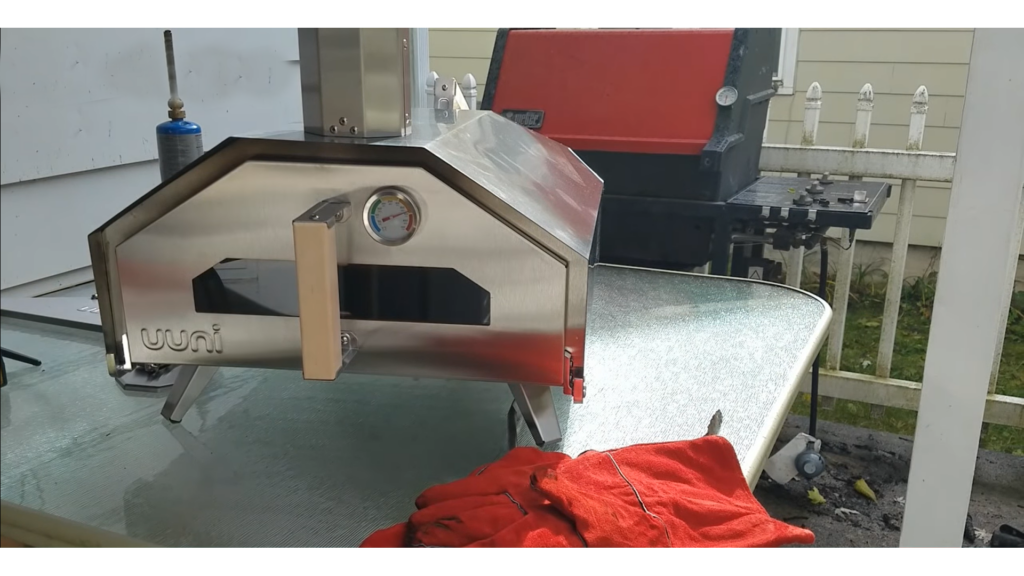
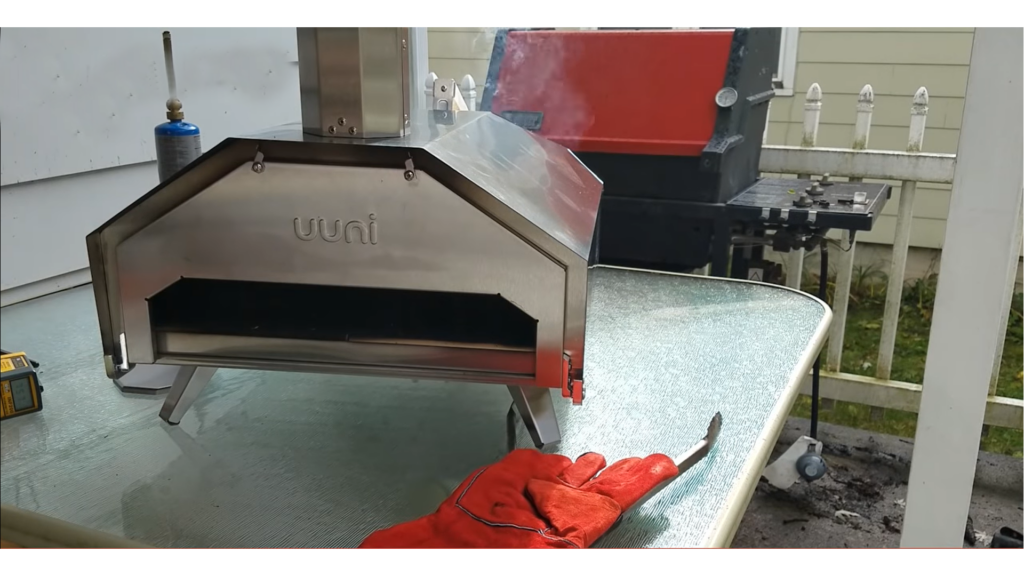
The other Ooni pizza ovens are more of an open design, except the Ooni Fyra and the Ooni 3 models which only have one door that doesn’t feature a built-in thermometer.
The second notable difference between the Pro model and the rest is the size. The Ooni Pro is one of the two largest models in Ooni’s collection of pizza ovens (the other one is the Ooni Koda 16).
It measures 31.1 x 19.29 x 29.13 inches, which is almost twice the size of the Ooni 3, Ooni Fyra, Ooni Karu and Ooni Koda 12 models. It’s a pretty big difference in terms of the footprint – it won’t fit into a small space. You’ll need at least a medium-sized table to place it on in your backyard, garden, patio, or rooftop.
Apart from the size, we found it to be quite heavier too than the rest. It weighs around 57 pounds which is double the weight of the other models (except the Ooni Koda 16). Being this too wide and heavy makes it the least-portable model of all Ooni pizza ovens.
We had no problems getting it out to our backyard although the weight and size make it a bit awkward to carry than the other slightly smaller Ooni models we’ve tested, plus there’s no real handle you can use to hold it – we moved it around on our stainless steel catering trolley. It will need two people or a wheeled cart if you are to move it around frequently.
That said though, it’s still transportable if you want to take it with you camping or a beach party. Both the four baking stones and the chimney are removable, and the three legs fold up underneath its base making it a bit lighter and easier to transport.
Our Score: 7 out of 10
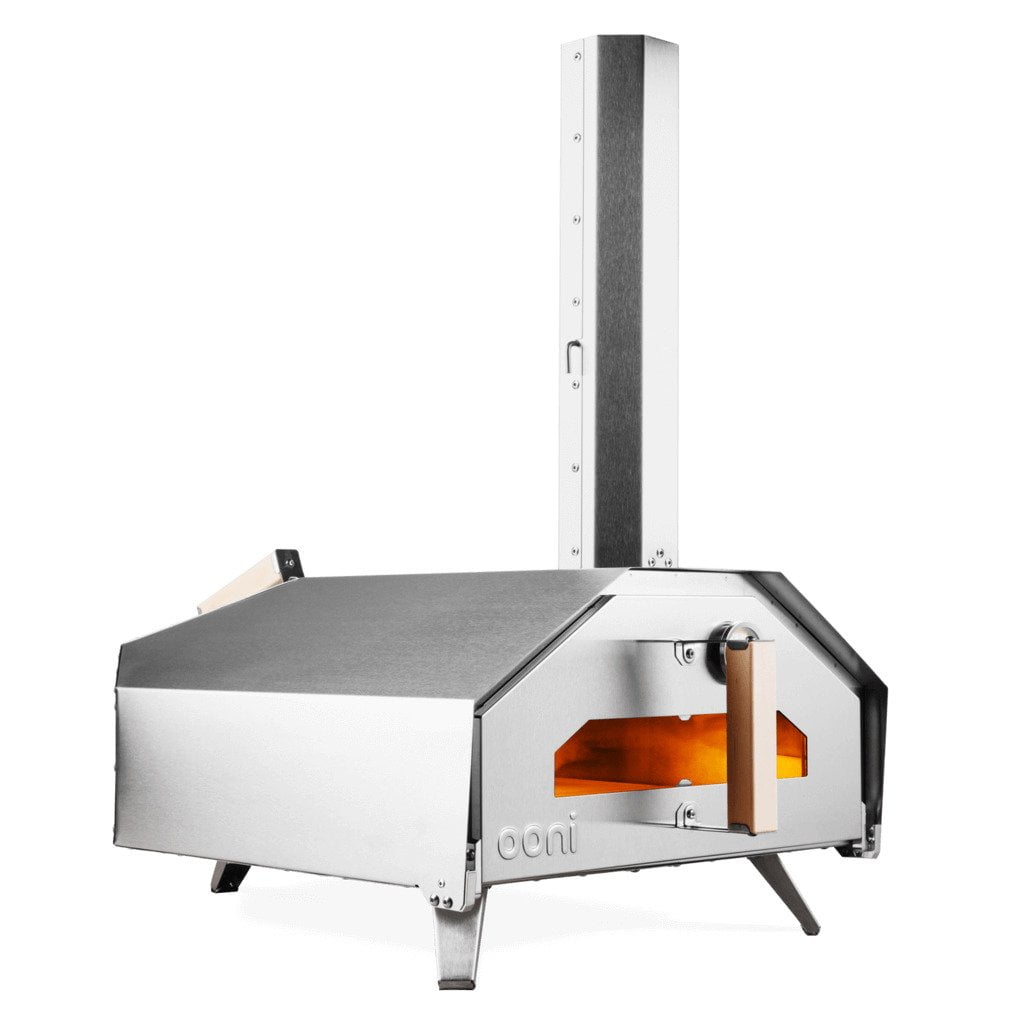
Ooni Pro
Build Quality
We found the overall build quality of the Ooni Pro to be pretty impressive. It’s a sturdy and durable pizza oven. The body is made using brushed 430 stainless steel which forms the exterior while in the interior, the roof is thick ceramic fiber insulation.
The baking boards, on the other hand, are four each 15mm thick and made from cordierite stone. They are thicker stones than that of the Ooni Koda, Ooni Fyra, and Ooni 3 (they are about 10 mm thick).
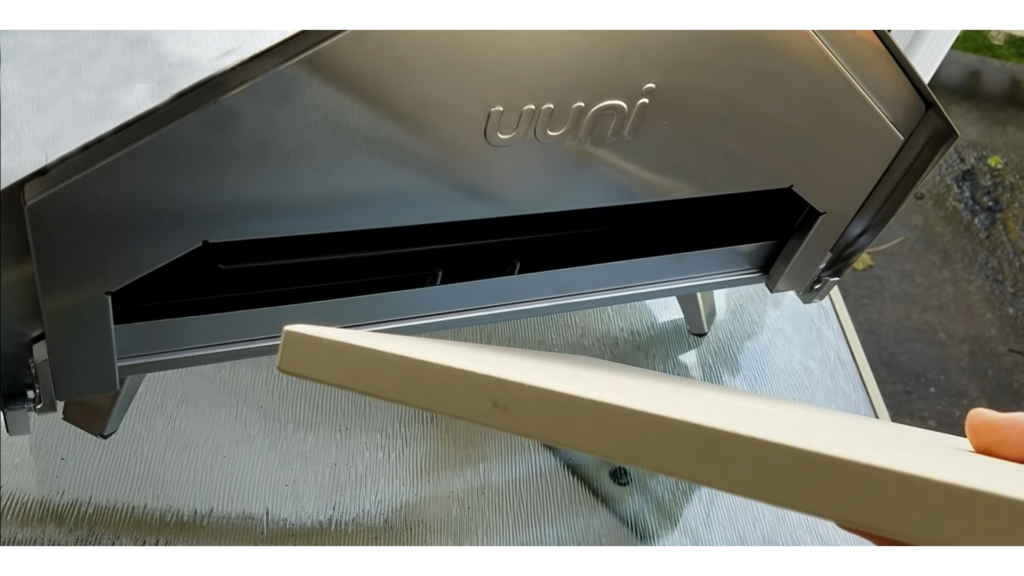
The wooden door handles on both the pizza door and the burner at the back of the oven are equally thick and remain cool to touch when the oven is cooking. Generally, the overall build is very solid/strong, suitable for outdoor cooking.
We haven’t had the oven for long to be certain, but the way it’s solidly built tells that it can withstand the outdoor conditions and regular usage for long. You can be able to use it all year long without it getting quickly damaged.
The double-walled design makes the entire body of the Ooni Pro rigid and seems to ensure sufficient insulation – the stainless steel exterior/finishing doesn’t really tarnish quickly or get discolored. It’s basically a unit that’s capable of making lots of pizzas before it wears out.
We did find the welding, especially of the shell to be a bit subpar. With the high temperatures, it’s likely to get some warping eventually which means that the door might start to get a bit stuck.
The three legs are shorter like that of the Ooni 3 model, but they are thick and do provide sturdy support to the oven. It remains stable when cooking.
Ooni has included a security loop too on the Pro which is a new feature that is indeed useful. It allows you to secure the oven to a work surface or any garden furniture to keep it sturdy and upright. It’s a useful feature that can help protect the oven against unwanted movement when cooking.
Our Score: 8 out of 10
Assembly
The Ooni Pro was easy to set up for us as most of the pieces simply click into place. An Allen key is provided which you use to screw in several pieces. The assembly process basically involves unfolding the legs on the main body. Then aligning the chimney and using the clip to securely attach it to the main body.
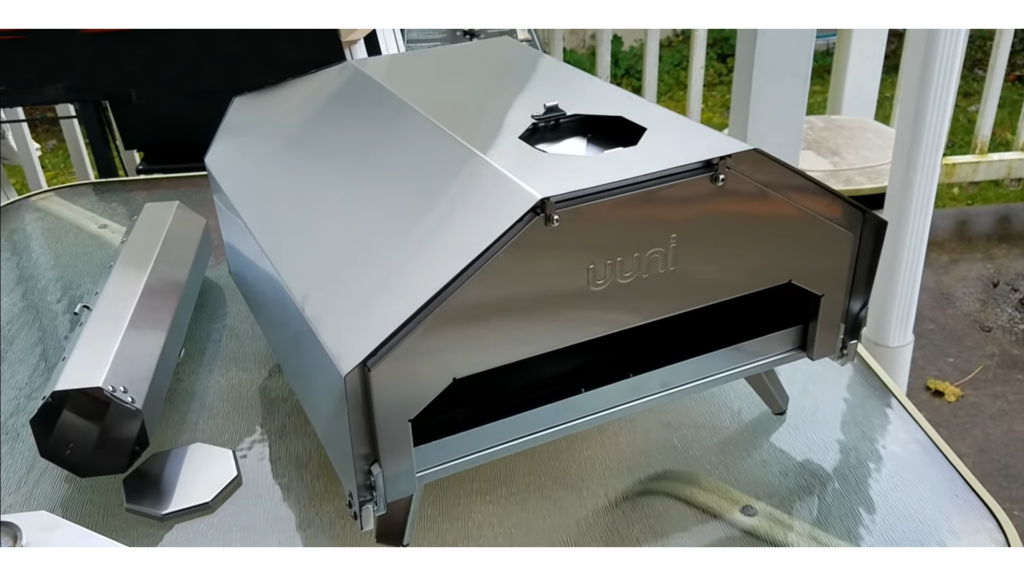
The next step is aligning the stone guard’s holes with the bolts that are located at the front part of the oven, and then tightening the included flange nuts by hand to secure the stone guard in place. The stone guard ensures that the baking stones are well secured inside the oven.
From there, you just slide in the four-piece baking stone inside the oven with each piece sitting on the four bolts located at the oven’s base. Once the stones are in place, you attach either the baking door or pizza door depending on what you are cooking (you must use the pizza door if you are attaching the gas burner).
The final pieces to set up are the fuel hatch door (attached at the rear) and the charcoal/wood burner (you slide it into the rear of the oven). It seems like lots of steps, but overall it was a quick and painless process. It took us about 10 minutes to get the whole thing put together. Moreover, Ooni provides an instructional video that helps guide you through the entire process.
Unlike the other Ooni ovens, this one will require a fireproof table/surface to sit on. The legs are very short and the bottom part does get a little hot which can scorch the surface it’s placed on.
A stone or metal table would do fine. You can place it on a wooden table provided that you put some tile on top (to absorb the heat) before placing the oven. We wouldn’t recommend placing it on a plastic or glass table.
What you get inside the box is the Ooni Pro pizza oven itself, a wood & charcoal-burner tray, the stone baking board (4 parts), oven door (with a built-in thermometer), pizza door (with a postbox-style opening) and the Ooni Pro manual and essentials guide.
The package also includes an Allen key to aid in the door installation and Ooni pizza oven gloves which are basic safety gloves.
Out of the box, the unit is able to use charcoal or wood chunks as their burners are included in the initial purchase. The gas and wood pellet burners are sold separately – the base model runs on only charcoal or wood chunks.
Other things you’ll need to get separately are the pizza peel, fire starters (if you use wood or charcoal fuel) and the Ooni weatherproof cover which is essential if you are going to leave the unit outside when not using it or if you reside in an area that receives lots of rain or snow.
As mentioned earlier, the oven door features a built-in thermometer which is meant to help tell the temperature inside the oven without opening the door. However, it isn’t always that accurate from our observation which could be due to its placement. It’s something that several other users also pointed out, so you’ll need an infrared thermometer in order to get the most accurate readings.
The included safety gloves are equally a useful addition to protect the hands from the heat considering that the outside does become very hot to touch during cooking, but they are not of the best quality. They seem like they can’t last long.
Our Score: 9 out of 10

Ooni Pro
Performance
For our tests, we used all the four recommended fuel types and there were no complaints with regards to reaching high temperatures. Similar to the other Ooni pizza ovens, the Ooni Pro was able to heat up to temperatures as high as 900°F (482°C), regardless of the fuel source we used. The difference came about in the time it took to heat to that high temperature.
Pre-heating Time
We found the propane gas to be the quickest although not as specified by Ooni. With the gas, the oven took about 20 minutes to heat up to 900°F. It’s the same time as the Ooni Koda model and most conventional gas kitchen ovens but much longer than the specified 10 minutes by Ooni.
The Oven took around 25 minutes to heat up to 430°C when we used the wood pellets and the charcoal which was slightly longer than the 20 minutes that Ooni claimed. The Ooni Fyra too took roughly the same time (around 20 to 30 minutes) to go up to 932°F.
We used the wood chunks in final testing and it took a fairly long time to get the oven piping hot. We waited for about 45 minutes for it to preheat which isn’t unusual when cooking with wood as your fuel but just heads up in case you’re someone that’s constantly in a rush.
The Ooni Pro has a larger heat area (9 inches) and it uses a similar design to that of the Ooni 3 – the burner is at the back (wood and charcoal burners) and the chimney at the front.
Heat distribution inside the oven was almost uniform when using the pellets and the charcoal although it took us a few tests to get a hang of how to control the airflow and the amount of pellets/charcoal to add to control the temperature. The chimney draws the flames and the heat forward and throughout the oven, so you get a relatively even heat distribution.
The charcoal in particular, performed fairly well. We were able to maintain a steady temperature by adding more or less charcoal and it didn’t require frequent adjusting of the vents.
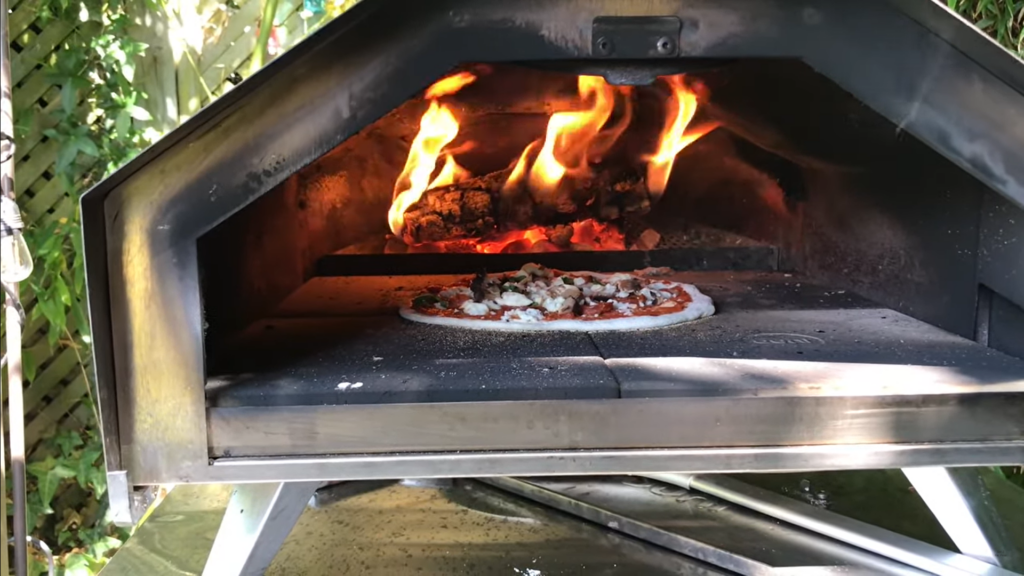
We used the gas burner and the results were even better. The Pro is heated by just two flames at the back and they remain steady throughout with all the vents closed. It doesn’t have an L-shaped flame like the Koda 16.
The design of the shell allows the insulation inside the oven to radiate the heat from the flame very well up to the middle and the front parts of the oven. It gets evenly distributed through the entire interior of the oven, plus the temperature always remained hot during our entire tests since we could more easily control it/ keep it constant.
We struggled to be consistent with wood chunks as fuel. Even though they burn faster compared to bigger pieces of wood, it’s a bit tricky to regulate the flame and ultimately the temperature. You can get a burst of flame when adding new wood to the fire even if you just add a little bit of wood which in turn alters the heat distribution inside the oven.
We used an infrared thermometer to check the temperatures of different parts of the stones and the interior of the oven. The front part of the oven and stones measured at around 694°F, while the back parts were significantly hotter reaching over 900°F throughout – it even maxed out our thermometer (1000°F) at the far back just near the wood burn.
Airflow System
The Ooni Pro airflow system was by far the best in comparison to the other Ooni pizza ovens. The chimney and the vent at the back of the Ooni Fyra did a great job during our testing with regards to circulating air inside it.
The Ooni Pro comes too with a dual airflow control although the positioning is a bit different. It has a chimney vent with an adjustable lever and a ceiling vent, both of which we found offer a much better level of control over the airflow and ultimately the internal temperature.
It doesn’t rely too much on the chimney. There are two small holes on the side of the oven’s opening which collect the air inside and then pass it in between the ceiling and the shell, and finally out through the chimney.
This movement helps limit the amount of air that flows in and out of the interior while equally allowing proper ventilation. Thereby, the fire doesn’t run out of oxygen – it keeps burning steadily, especially when using propane gas, wood pellets or charcoal as fuel.
The Ooni Fyra air circulation system of a chimney at the front and vents at the back (firebox) isn’t always reliable despite performing great. The air comes in from the back and blows the fire/flame upwards toward the chimney opening. The airflow can sometimes be too much such that it blows too hard on the flame/fire and there’s little you could do to control it.
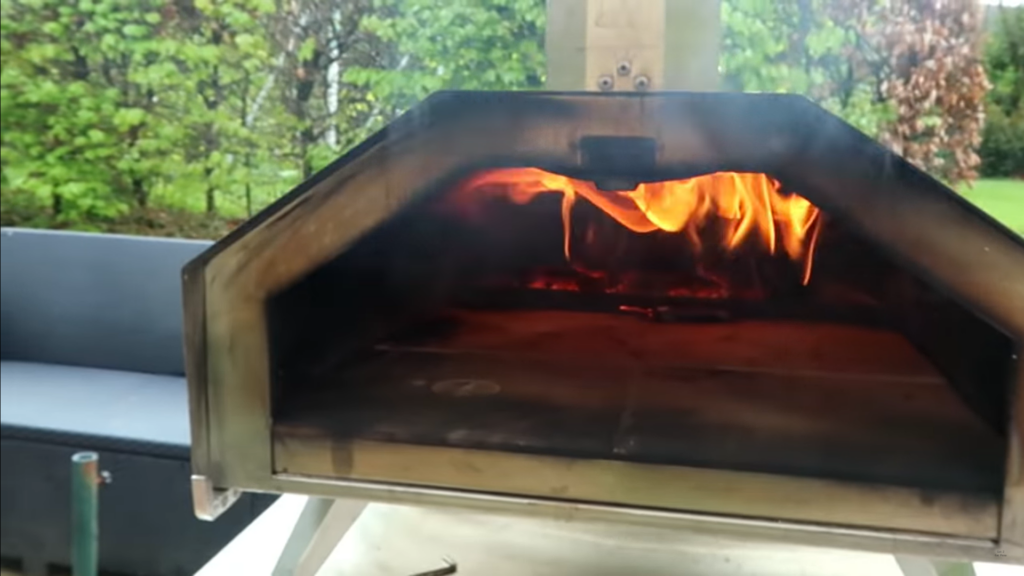
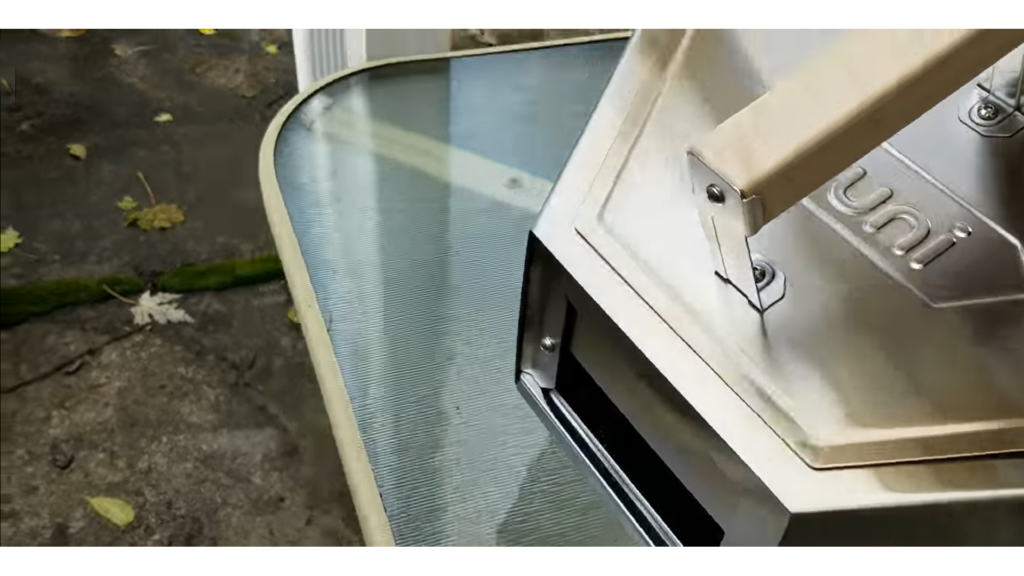
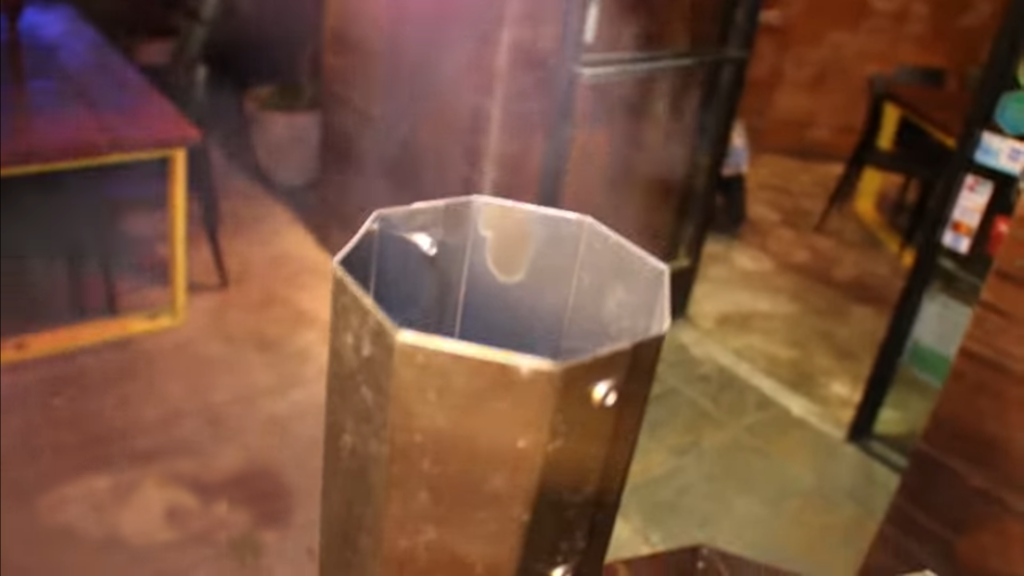
The Ooni Pro has dampers in the chimney just like the Fyra that let you adjust the airflow. You can tweak the amount of air through the chimney. When you place the lever in the vertical position and keep the ceiling vents open, you get maximum airflow and the pellets, wood or charcoal burn hotter thereby raising the temperature.
When you move the lever to the horizontal position while the ceiling vents are opened, the airflow is reduced hence reducing the flame and also the temperature.
Closing the ceiling vent while the chimney lever is vertical allows heat to billow around the front part of the oven before it goes out through the side channels as well as the open chimney – this allows you to also cook at slower, lower temperatures.
Generally, we felt the Ooni Pro offers better control over the airflow than the Ooni Fyra or the Ooni Karu – you can easily maintain sufficient airflow and heat distribution through the entire interior of the oven. It takes a bit of practice and the changes might not be quick when making adjustments, but it’s definitely doable.
The fuel you might struggle to deal with a little due to smoldering is wood chunks, especially when you add a new piece or more. With the gas burner, it’s relatively simpler to control the temperature – you just adjust the control knob to adjust the flame and therefore the heat.

Ooni Pro
Heat Retention
The Ooni Pro is apparently quite good at keeping the heat in even with the pizza door that has a letterbox-style opening. It has a sturdy steel body that’s very well insulated.
The thick ceramic fiber material on the inside within the steel frame, walls and the door provides great insulation. The heat from the fire/flames doesn’t escape, it’s kept in. We noted that the exterior (the shell) as well as underneath the oven, doesn’t really get too hot like is the case with the other Ooni models.
The cordierite baking stones are very thick (double the thickness of Ooni 3 and Ooni Koda) and they hold their heat better.
The completely closed oven door proved useful too in retaining the heat inside the oven. When preheating the oven, we used it to prevent the heat from escaping out from the front and the results were impressive. There was little heat loss, even while slow-cooking.
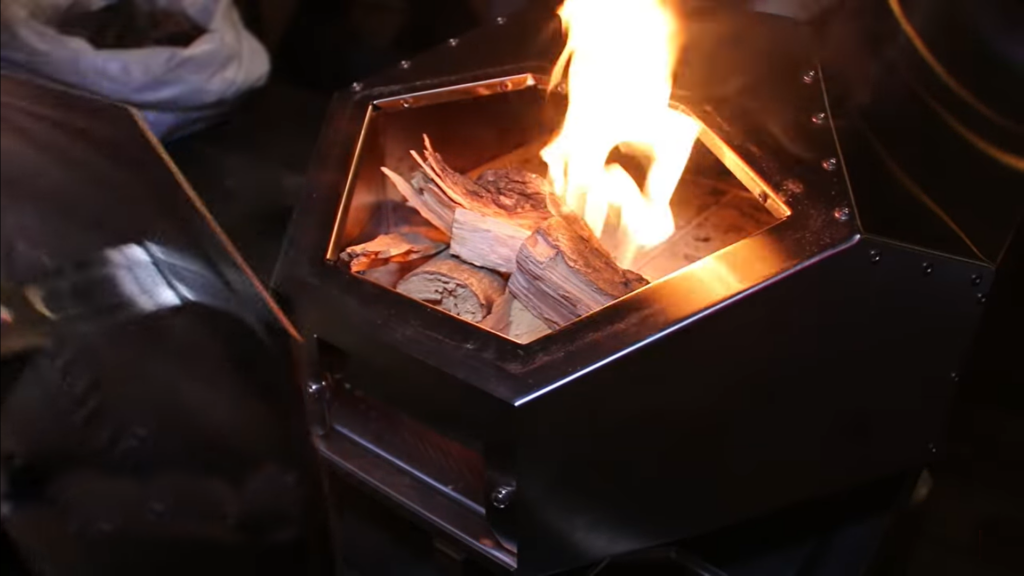
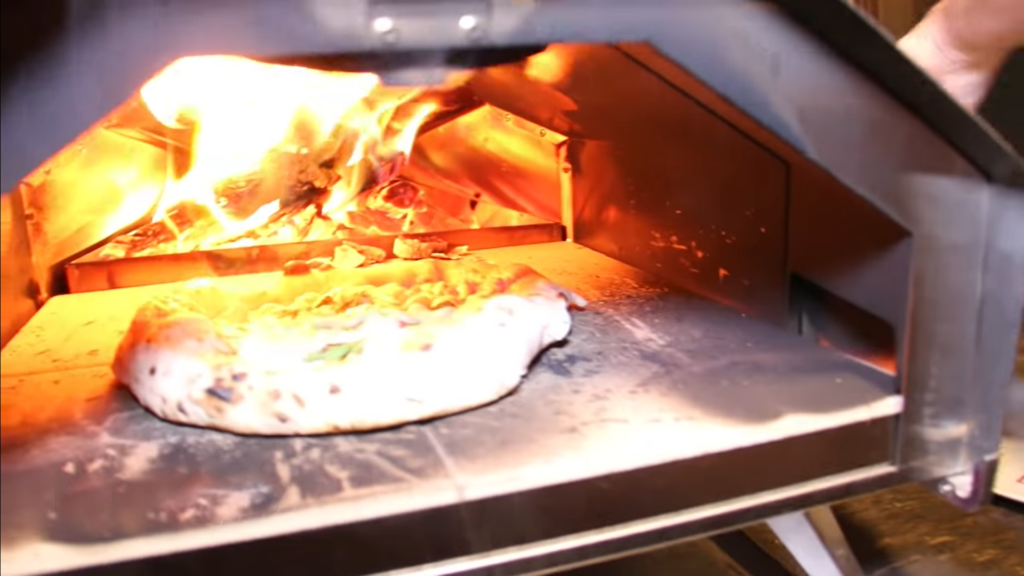
We did note slight drops in temperature after each cook though which is something several other users reported having experienced with this Ooni Pro pizza oven.
For our case, it was the stones that drop in temperature after sliding in the pizzas (they would reduce from 482°C to about 400°C), particularly when using wood pellets, charcoal or wood chunks. You have to continuously top up the burners to get the heat back up and keep it at maximum temperature.
The recovery time wasn’t much of an issue, however. The stone took less time to recover the heat – we didn’t wait long (about 2 to 3 minutes) before putting in the next pizza.
Our Score: 7 out of 10
The Results
As mentioned earlier, this particular unit is able to run off propane gas, wood pellets, charcoal or wood. We used all these fuels during our tests and the results were different with each one of them.
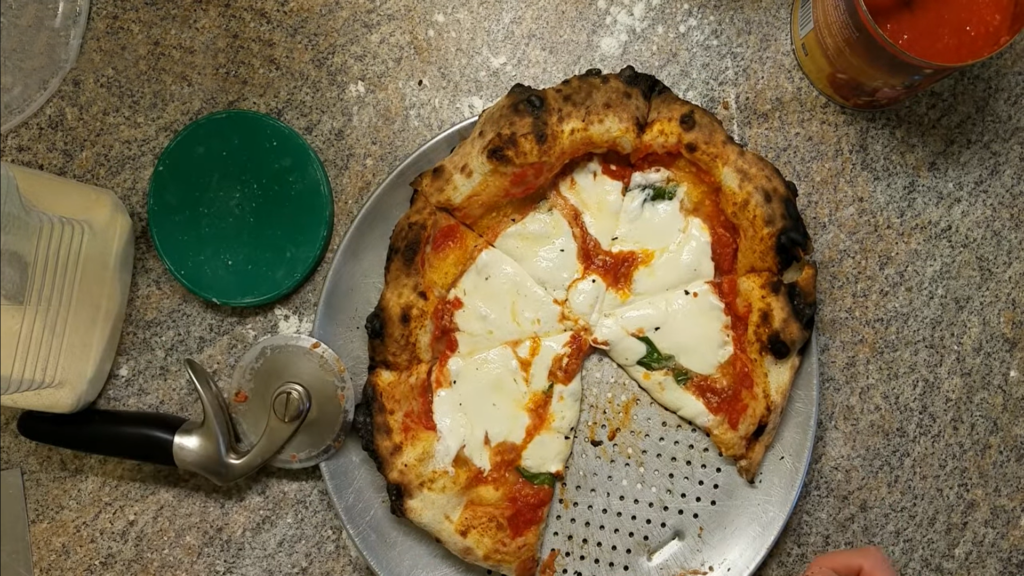
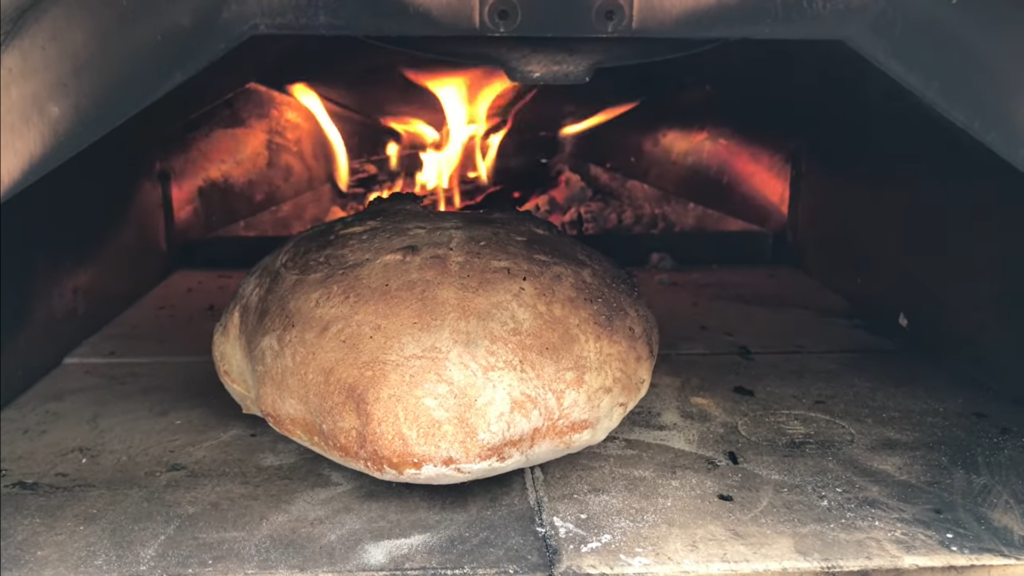
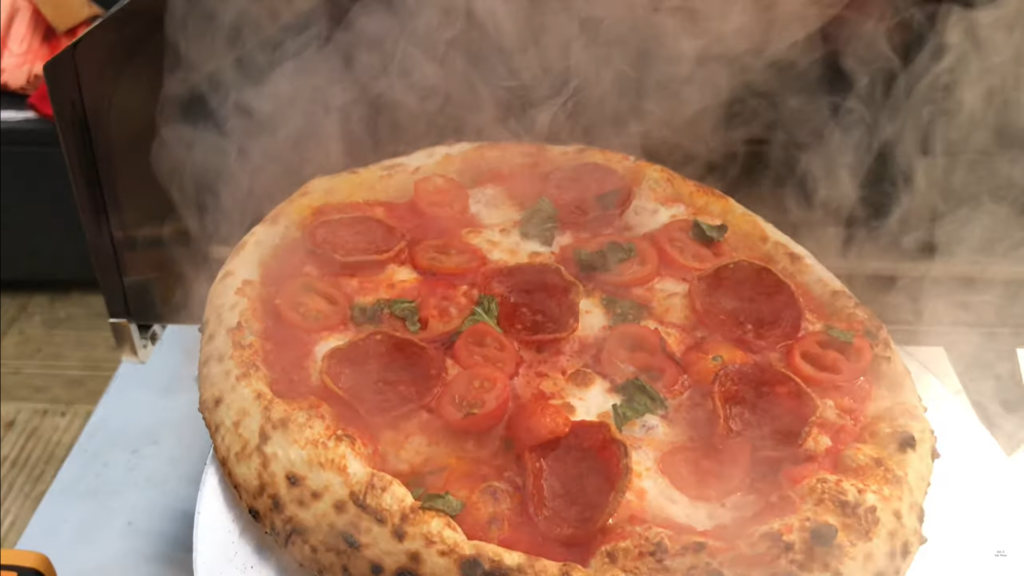
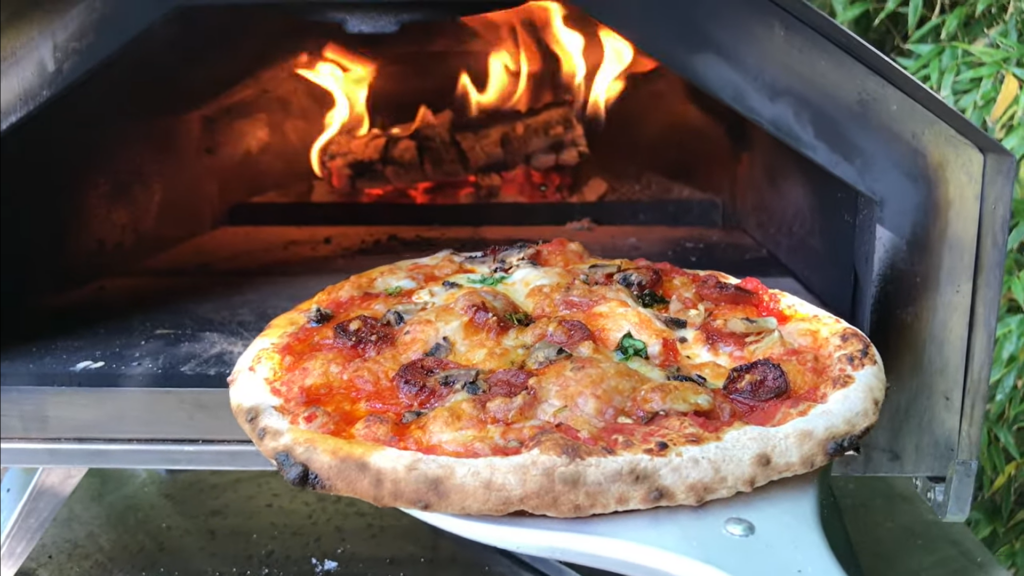
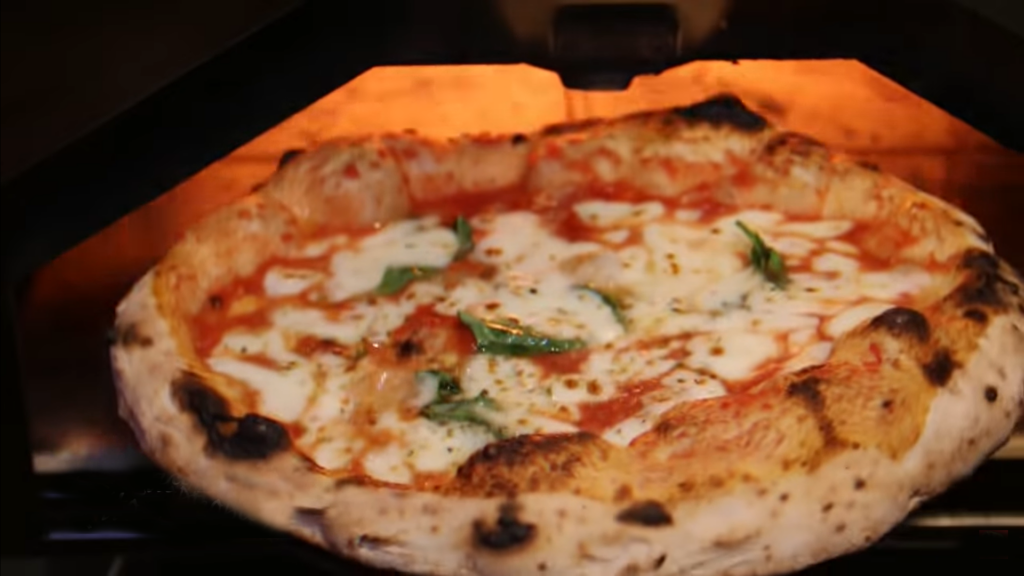
Gas Fuel
We used propane gas for our first cook and it performed very well, much like we expected with most gas-fueled pizza ovens. The oven maintained a temperature of 800 to 900°F through the cooking in spite of the cold windy conditions we had when we set out to cook out the pizzas.
It maintained the high temperatures and cooked the few pizzas we had quite fast. We made 4 pizzas and on average it took around 90 seconds to cook each. It can vary between 60 to 90 seconds depending on the thickness of the dough and how much toppings you put – it takes slightly longer to cook if the dough is thicker and the toppings are more.
We slid the first pizza in and ensured its edge was roughly 3 inches away from the oven’s mouth because the heat was concentrated more at the back even though the middle and the front part were equally hot. There was only a slight difference at first.
We let each pizza sit for around 20 seconds every time before turning it with the peel at about 120 degrees so that we would make three turns around in order to get all sides cooked.
The Pro was able to cook the four pizzas consistently and evenly, plus the bases were beautifully crispy. The cordierite baking stones retained the heat well after preheating for more than 20 minutes and stayed hot when we placed the first pizza on it.
It cooked the base quicker and it had a great finish – it seems the heat got deeper into the stone allowing it to absorb moisture quickly from the dough and cook the base of the crusts very well. They had a nice texture with only small burnt spots often referred to as “leoparding.” The crust itself was crunchy and flaky – it had a slight carbon/char taste from the leoparding.
The toppings, on the other hand, were cooked thoroughly. The flames from the gas burner rolled over to the top of the oven hence there was enough heat over the top of the pizza which cooked it well and quickly. The middle of the pizza was equally cooked properly – the inside was soft and chewy while the outside of the crust was nicely crunchy.
Our fourth pizza was a Sicilian-style pizza which is a pizza that requires baking for long at a lower temperature. It worked out pretty well – the oven managed to hold the temperature constant over the long baking time.
Generally, we found cooking with gas fuel easy and predictable since it was simpler to pre-heat longer and it kept the heat consistent, plus we could even easily adjust the flame/heat using the thermostat or regulator.
A few customers on several online forums did mention though that they experienced a slight temperature drop when cooking with gas over a long duration. We didn’t experience the same and it wasn’t a widespread issue but it’s worth taking note of.
Our Score: 8 out of 10

Ooni Pro
Wood Chunks
We struggled a lot to be constituent with the wood chunks as the fuel. Maintaining the temperature throughout for an extended period was the biggest challenge to us. The fire was rapid for the most part and whenever we added a new wood chunk. It took several trials to get a hold of how to maintain the heat at even cooking levels.
We had to rotate the pizzas more frequently than when using the gas because it gets significantly hotter at the back of the oven than in the front. It was simply cooking quicker than we could turn the pizzas, so we ended up with a few burnt pizzas.
The crust on the first pizza dough we put was burned pretty badly. We slid it in almost near the back of the oven and even though we were going to rotate it, we didn’t know how quickly we needed to do this. Within just a few seconds (probably less than 20 seconds), we pulled the pizza out and noticed that the crust which was close to the flames was completely black.
We continued cooking the remaining pizza pies and tried to rotate them quicker, and two worked out fine. Their crusts didn’t get burned as badly as the first one. It took around 50 seconds to cook each one of them with three rotations.
The fourth one was rather a disappointment. The crust and top were burnt while the base was soggy. We did the fifth one and this round the bottom was burnt while the top was raw (we added a new wood chunk and slid in the pizza without waiting for it to catch fire well).
We decided to do a last one but first, we put in several small pieces of hardwood and let them burn well so as to get the flame going inside the oven.
We rotated the pizza much quicker this round and it did come out much better although still there were a few large dark areas on the crust (not like the learpading with the gas fuel). It took around 50 seconds like the second and third time before the pizza was done.
Part of the problem was the thickness of our pizzas. We couldn’t get the proper thinness we wanted with the dough of the first pizza. It was thick and ended up cooking slow and getting burnt as the flame from the wood was hot. It was the same case with the fifth pizza.
Our turning time was also another problem since it was a bit slow – the bottom and the back burnt too fast for us to handle or time them right. It requires a balance between keeping the temperature steady and turning the pizza on time which we didn’t get it right every time, and many other people on some of Ooni’s pizza online forums mentioned that cooking with wood was relatively challenging.
Our Score: 6 out of 10
Wood Pellets and Charcoal
It was a bit simpler to cook with wood pellets and charcoal. It took a few trials at first to get the hang of timing and turning, as well as the ideal cooking temperature to use, but after cooking two pizzas it became easier and we were getting better results.
We did have to rotate the pizzas frequently to get them baked evenly since our testing with an infrared thermometer showed temperature varying slightly between the back and the front of the oven.
Using just charcoal, we put our pizza in the center of the oven and waited about 20 seconds and rotated it. We didn’t rotate it as frequently as we did with the wood fuel and the crust nor the bottom burned at all. The pizza turned out great with the crust crispy and the cheese gooey, just the way I like it.
The temperature inside didn’t get occasionally too hot as it did when we were using wood. The pizzas took around 60 seconds to cook completely and the toppings came out well done in 3 of the five pizzas we cooked.
We also tried the Sicilian and additional Detroit pizzas which both need cooking for long at low temperatures. The results were not as impressive as when we used gas mainly because the temperature wasn’t very steady throughout but nonetheless they were decently cooked if we were to use wood chunks.
You need to keep an eye on the pizza though to rotate it before the crust near the heat source begins to burn and regularly keep topping the same amount of charcoal or pellets to keep the temperature constant.
In general, from our experience, it takes a bit of learning and a few failed trials to get a properly cooked pizza with this Ooni Pro model, particularly when using wood as fuel.
You also have to keep the toppings simple – the more toppings you have the longer it’ll take for them to cook well, which consequently puts the crust at increased risk of getting burnt in the intense heat. You get a proper pizza when cooking simple ingredients like Margherita pizza with basil and buffalo mozzarella.
We also noted that you get better results when you stick to the thin dough because it cooks more evenly and usually comes out crisp. You also have to preheat the oven for an hour regardless of the fuel you use in order to prevent sticky pizza bottoms and significant temperature drops once you slide in the pizza.
Our Score: 8 out of 10
The Cooking Space
The Ooni Pro much like the Ooni Koda offers one of the largest interior spaces on the market. We were able to cook pizzas that are as large as 16-inches.
It has more room than most portable pizza ovens such as the Ooni Fyra, Ooni Karu and Ooni Koda which can accommodate a maximum pizza size of 12 inches. We found the Pro basically the ideal choice for cooking family-size pizzas or for casual entertaining.
Launching and taking out the pizzas was easy as the opening of the pizza is wide. You have more space to work with – you don’t hit the sides or the top when loading and removing the pizzas.
The larger interior and opening of the Pro equally allows you to insert an iron skillet or any flat dish. Coupled with the fact that it offers better airflow control (with chimney and ceiling vent), you can cook other types of food beyond pizza.
You can roast meat, fish or vegetables, or bake bread. We tried to cook items like chicken thighs at lower temperatures and the results were incredible. They were well cooked inside and outside although we had to monitor the cooking throughout to prevent the outside from getting scorched.

Ooni Pro
Cleaning
The Ooni Pro does a decent job of keeping itself clean just like most of the other pizza ovens. The high temperatures it operates at burn up just about everything leaving you with very little to clean – no need of disinfecting the cooking surface.
The only frequent issue is leftover ash that accumulates when cooking with wood, charcoal or wood pellets. We made like 10 pizzas in it yet there was no significant ash accumulation.
We constantly removed the burner tray after every 5 pizzas we cooked and dumped out the little ash left behind. We had a small brush that we equally used to sweep out the ash from the wood/charcoal burner tray.
You have to wait for the oven to cool down completely before cleaning – it can take an hour based on the temperature you were cooking at. Once it cools down, you can use a non-abrasive brush to sweep out the ash and any other crumbs.
The stainless steel exterior was simple to clean as well. It doesn’t show fingerprints or smudges. A simple stainless-steel cleaner can easily clean it but it should be non-abrasive.
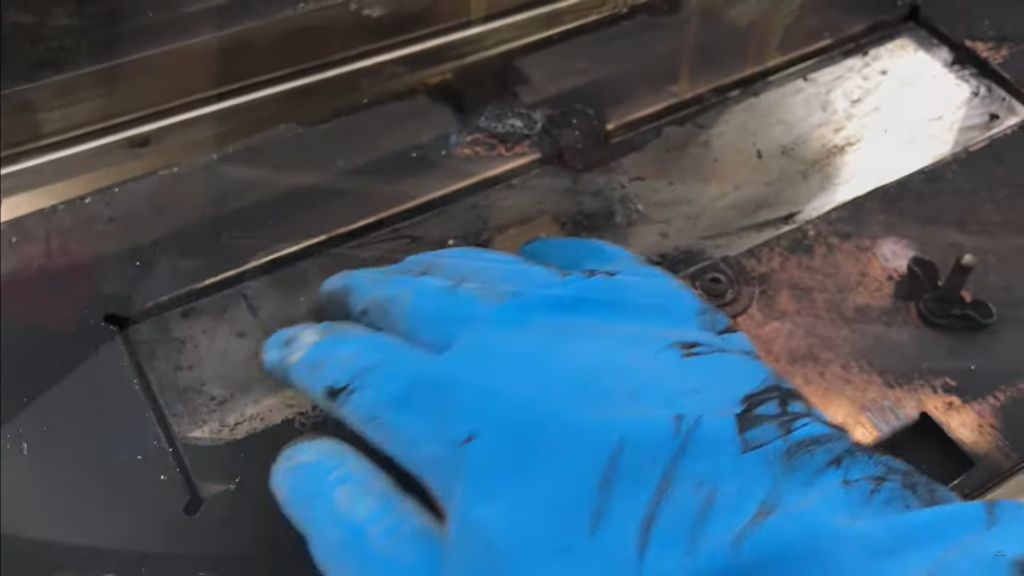
The manual that’s provided gives clear maintenance suggestions. One thing we learned is that the pizza stone must be scraped after each use, otherwise, the next pizza sometimes tends to stick and become difficult to remove.
Our Score: 9 out of 10
Other Highlights
The versatility of fuels is something that completely hooked us in, of course besides the size of the interior. The fact that you can use wood, charcoal, wood pellets or gas was a great advantage according to us when compared to all the other Ooni pizza ovens.
We found gas to be the easiest to use but as outlined earlier, you’ll need to purchase an Ooni propane gas adapter/burner for this particular Ooni Pro model.
It’s a small attachment that’s easy to connect. You simply attach it to a regular propane tank just like a grill. It’s a convenient option for quick and easy pizza cooking. The trade-off is the cost because the gas burner adds an additional cost which is almost double the price of Ooni Koda’s burner.
The charcoal/wood pellets do require some work than the Ooni Karu or the Ooni Fyra, but its performance is good and it gets easier to use over time once you get a hang of it.
We found the Ooni Pro’s wood burner a bit more hassle to use than the other fuel sources. It wasn’t fairly easy as the pellets and the results were not that impressive for the most part of our tests. You can only use a hardwood like oak, not softwood like pine – it will smoke a ton and soot can get everywhere, including sometimes on the pizza.
The temperature gauge was another major highlight considering that the other Ooni models don’t have one but it proved not useful in our testing. The readings weren’t mostly accurate and you can’t tell the temperature at different parts of the oven unless you use a separate infrared thermometer.
Can you Use Ooni Pro Indoors?
The Ooni Pro is designed for outdoor use only. It gets to an extremely high temperature very fast and can produce a lot of smoke that can fill a room making it completely unsafe to keep inside – it can be a serious fire hazard if used indoors.
Moreover, it’s quite large in size, so you can’t cram it into a small space. You’ll have to place it somewhere that provides clearance (about 3 inches from the back of the oven to the wall) behind the oven so as to allow for airflow.
The area above the chimney stack has to be open as well because of the extreme heat that escapes out and up through it. If there’s a roof or an overhang closer to the stack then you’ll get some serious warping and discoloring.

